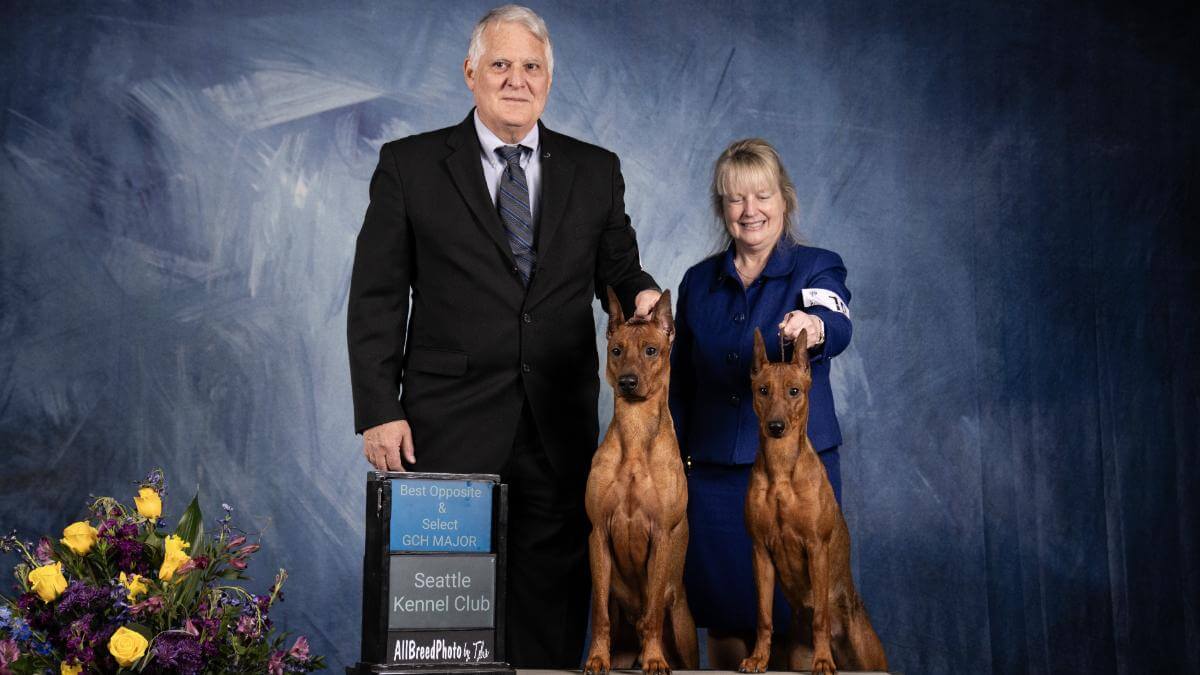
Home » Howard & Lorraine Shore | Immer Treu

Howard & Lorraine Shore
1. We have been involved in the sport of dogs since 1995 when we began showing our Airedale Terrier. After he passed away, we researched various dog breeds using the AKC Dog Book and found the German Pinscher which had the qualities we were looking for in a dog—medium size, ease of grooming, and vermin hunting.
After many months of researching breeders, we acquired our first bitch in 2007 from a breeder in Prince Edward Island, Canada. We bred our first litter in 2009 and named our kennel “Immer Treu German Pinschers.” Immer Treu is “Always Faithful” in German and describes this breed very well. We moved from Alaska to Washington State and became very active in breeding, training, and exhibiting German Pinschers in Conformation as well as trialing in Scent Work, Rally, Obedience, and Tracking.
2. The hallmarks of a German Pinscher are a medium size, short-coated dog with a strong, square build, moderate body structure, muscular and powerful for endurance and agility. They are active, fearless, self-possessed, intelligent, and loyal with a natural vermin hunting instinct.
The German Pinscher is a true working dog, and maintaining breed type by producing dogs with correct structure and temperament is what we strive for as breeders. This is a relatively new breed in the United States, as they were only recognized as a breed in 2003 by the AKC, and there are very few breeders across the country. It is imperative that breeders work together to improve our breed and educate the public about this wonderful and rare breed. A well-bred German Pinscher is a terrific dog that fits in with most families, and my hope is that someday our wonderful breed is no longer on the endangered list.
3. Yes, we maintain a wait list of puppy buyers and frequently refer interested buyers to other breeders when we do not have a puppy available.
4. The advancements in genetic testing have been instrumental in improving the health of many breeds, and while the German Pinscher is overall a very healthy breed, we do use Embark for a comprehensive DNA panel on our dogs. Communication technology has exploded in the last decade and has created opportunities for breeders to work with other breeders around the world very easily utilizing social media and breed-specific databases to document health testing and pedigrees. The German Pinscher Global Database was started by a breeder overseas and is currently managed by breeders in the United States. This database has been extremely helpful with pedigree analysis, health information, advertising breeding stock, and planning litters.
5. We have been active in our local dog club, Hurricane Ridge Kennel Club, since we moved here in 2008 and have seen a progression from a majority of dog owners in our area having purebred dogs to more mixed breeds. This is in large part due to the “Adopt, Don’t Shop” campaigns and the doodle craze. HRKC works diligently to educate the public on the benefits of purebred dog ownership and promotes responsible breeders and responsible dog ownership. I believe it is vitally important for purebred dog owners and clubs to continually educate the public on the benefits of purebred dogs to dispel the myth of hybrid vigor and longevity in mixed breeds. Purebred dogs provide predictability in size, temperament, health, and coat maintenance, which is extremely important for the average pet owner. Purchasing a dog that was bred specifically to perform a certain function provides a pet owner with the ability to choose the right dog for their family.
6. Our local kennel club has experienced declining entries over the last 10 years; however, in the past two years they have slowly been creeping up. We used to have over 1,000 entries and are now down to 500-600 per day. The German Pinscher Club of America National Specialties have dramatically declined in entries over the last several years, with an average entry at a National in the last few years of 10-20 compared to entries of 50-60 dogs in 2009-2012. I believe this is due to several factors, including declining interest in purebred dogs, animal rights legislation targeting breeders and vilifying purebred dog owners, as well as the economic downturn in our country over the last decade. Our parent club is working to become more active in educating the public about our breed and recruiting members, which is essential to the survival of the German Pinscher.
7. The positive changes have come about as a result of social media, which created opportunities for education, marketing, and communication about purebred dogs, anti-breeder legislation, and promoting responsible dog ownership. Additionally, the advent of multiple dog sports, particularly Scent Work, has increased participation by dog owners in AKC competitions. These sports are open to all breeds, including mixed breeds, and are extremely popular with dog owners as they create a tremendous bond between the owner and their dog. As more and more dog owners compete in these sports they are exposed to multiple purebred dogs, which creates learning opportunities about each breed, thereby helping to educate the public on the benefits of purebred dogs.